
When Karen Dudley closed her iconic restaurant, The Kitchen, in Woodstock, Cape Town, there were tears all over for the beloved establishment. Since then, Karen has found that connection does not necessarily reside only in bricks and mortar. She has found that she can carry that deliciousness onwards. This book is about how she has done just that.
INDEX
Chana Flour & Butternut Pancakes
Red Cabbage with Capers, Basil & Pine Nuts
Ukrainian Yoghurt Pancakes or Little Doughnuts
‘Smoked’ Basil Chicken Thighs
“Who doesn’t love the flavour of chicken cooked over fire? It has taken Saliha Mahmood Ahmed to teach me this Mughal cooking technique, dhuandar: a way to impart the flavour of smoke into cooked chicken without fire! My friends in Durban have been doing this for generations. Ah, I have so much to learn!”
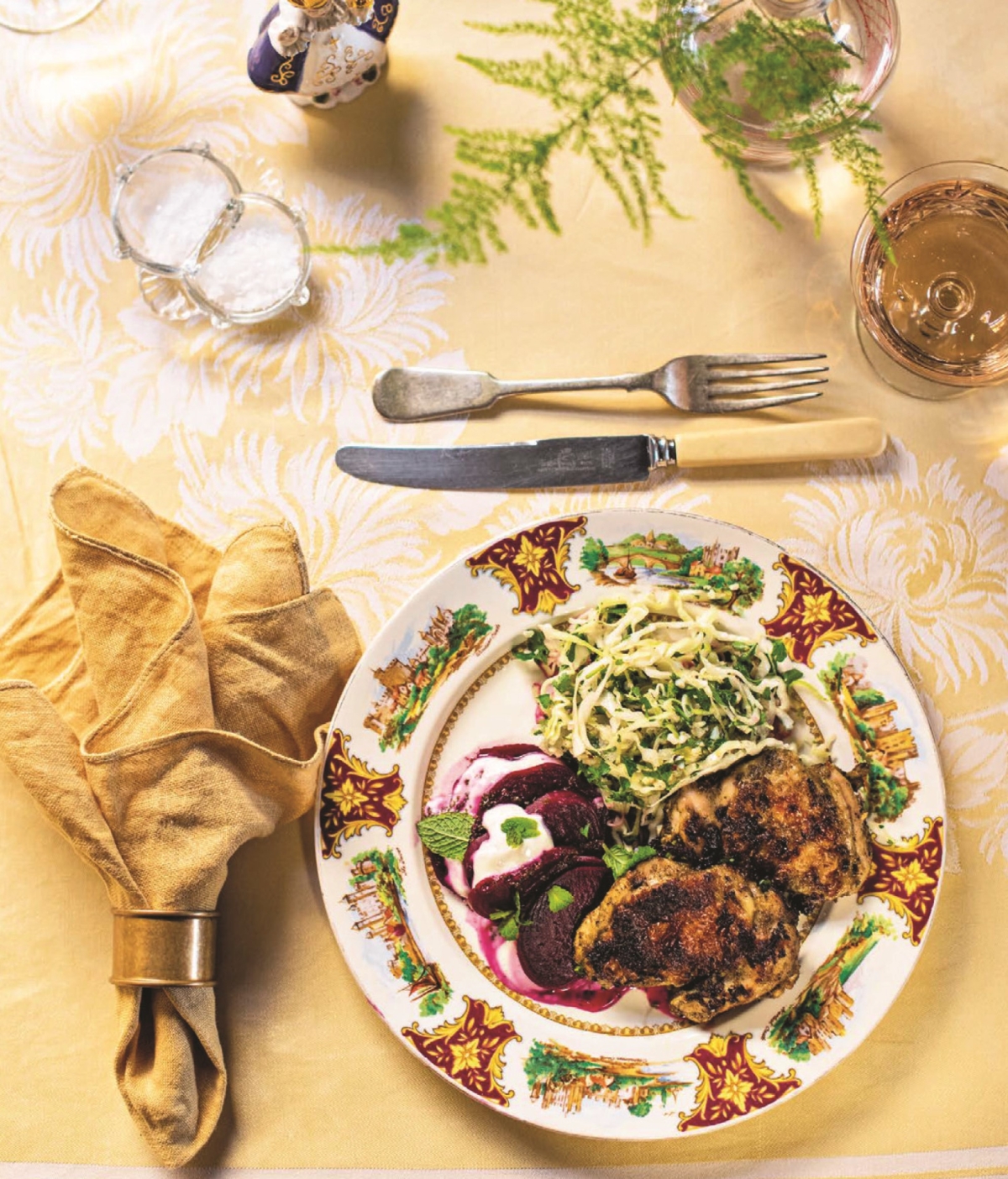 Serves: 6
Serves: 6
FOR THE CHICKEN MARINADE
100 g Greek yoghurt
3 tsp grated ginger
1 clove garlic, finely grated
30 g fresh basil leaves, divided
1 Tbsp garam masala
1 Tbsp dried chilli flakes
1 Tbsp cumin seeds
1/2 tsp salt
FOR THE SMOKED CHICKEN
800 g boneless chicken thighs (see note)
1 small piece of coal, about 4 x 4 cm
Vegetable oil, for grilling, + 1 Tbsp
To make the marinade, add the yoghurt, ginger, garlic, half the basil leaves, garam masala, chilli flakes, cumin seeds and salt to a food processor. Blitz until you have a smooth green puree.
Place the chicken thighs in a glass or casserole dish. Pour your chosen marinade over them. Cover with cling wrap and allow the chicken to marinate for 30 minutes. If you are marinating the chicken for longer than 30 minutes, store it in the fridge.
Preheat the oven to 220°C.
Take a piece of coal and, using kitchen tongs, hold it directly over a gas flame. Getting the coal glowing takes longer than you might think, so get this process going a good 15–20 minutes before you plan to use it.
Place a griddle pan over high heat and brush it lightly with vegetable oil. When it is super-hot, grill the marinated chicken thighs for 5–7 minutes on each side, until cooked through. Place the cooked chicken in a casserole dish with a lid or a heavy cast-iron pot with a lid.
Here is the fun bit: put a large metal serving spoon into the casserole dish on top of the cooked chicken and place the glowing coal on the spoon. Working quickly, pour the oil onto the piece of coal. Smoke will form immediately! Quickly replace the lid of the casserole (no peeking!) and allow the smoke to infuse the chicken for about 15–20 minutes (the pot need not be on the heat).
Serve with a tamarind or garam masala raita and a lovely salad. Top with the remaining basil leaves.
NOTE:
I love smoky chicken skin, so I usually debone the thighs myself just so I can get some skin. Skinless thighs are readily available at the supermarket and work well, too.
Chana Flour & Butternut Pancakes
“We are always looking for vegetables to use as a vehicle on which to pile salad and toppings. This is a really good one. You could add avocado or a fried egg, leftover shredded chicken or sausage – but always top with fresh, well-dressed leaves. Phew! A grounding pancake offers up a world of deliciousness!”
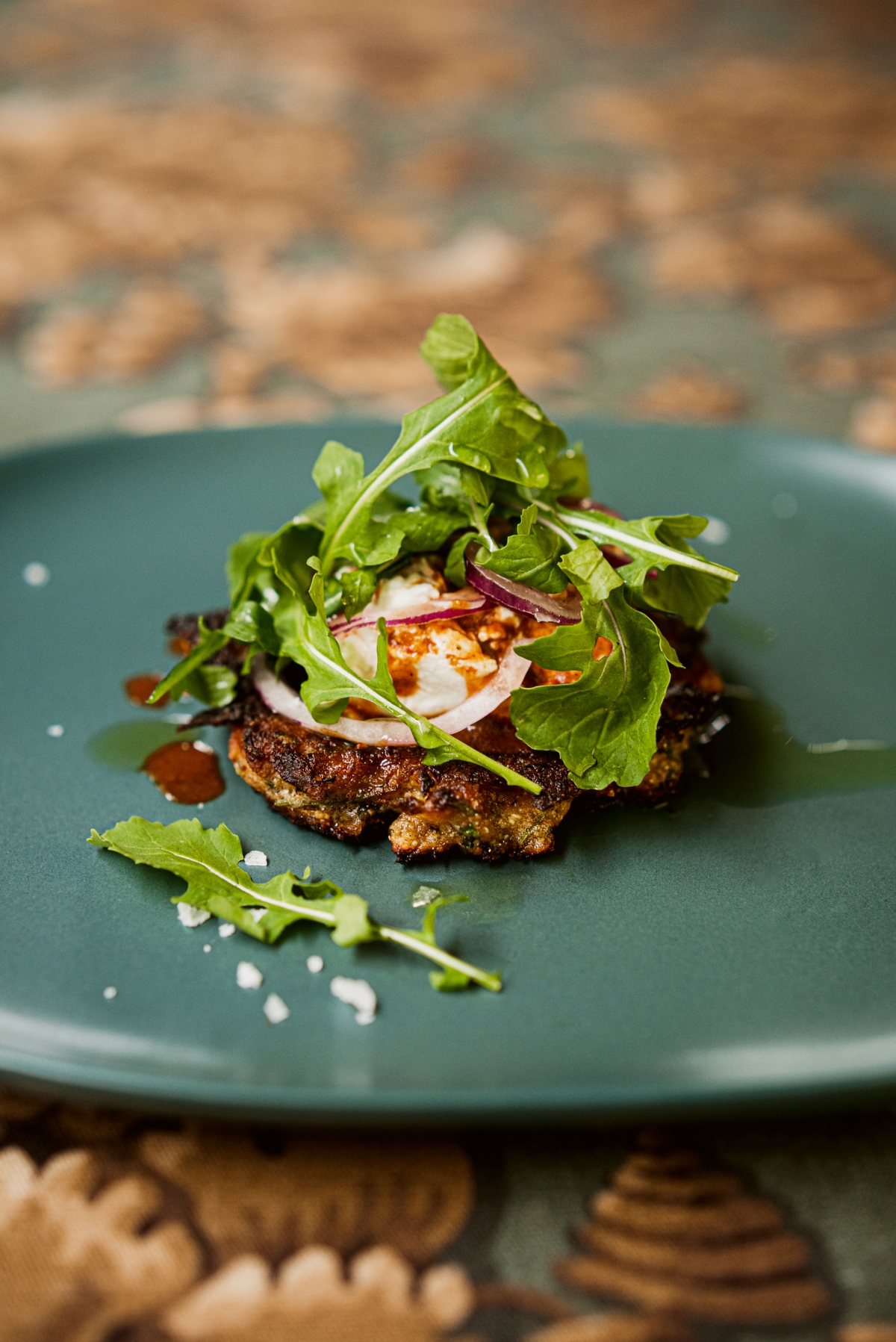 Serves 4
Serves 4
450 g butternut, peeled and coarsely grated
½ tsp fine sea salt
¼ tsp cumin seeds
¼ tsp coriander seeds
¼ tsp fennel seeds
4 large eggs
1 tsp ground cinnamon
1 tsp ground ginger
1 tsp sugar
1 clove garlic, minced
2/3 cup chana (chickpea) flour
½–¾ cup fresh coriander (leaves and stems) chopped
½ cup oil, for frying (about 2 Tbsp per pancake)
½ cup crème fraîche, full-cream yoghurt or labneh
3 Tbsp çemen paste + 1 Tbsp water (to make a dressing), or your favourite pesto or relish
½ red onion, very finely sliced
100 g wild rocket, watercress or mizuna
1 Tbsp olive oil
Flaked sea salt and freshly ground black pepper, to taste
NOTE:
You could substitute the butternut with carrots.
Place the grated butternut in a colander and sprinkle with the fine sea salt. Mix the salt through the butternut, allowing it to draw out the moisture and soften a little. Leave this in the colander for 10–15 minutes, before squeezing out as much liquid from the butternut as you can. There won’t be a huge amount but this step is important for making a crispy pancake.
Dry-fry the cumin, coriander and fennel seeds in a small pan until fragrant. Grind these toasted whole spices in a coffee grinder until fine.
Crack the eggs into a large mixing bowl and whisk. Add the freshly ground spices along with the cinnamon, ginger, sugar, garlic and chana flour. Whisk together, then stir in the butternut and coriander. Mix with a wooden spoon until thoroughly combined.
Heat a large frying pan over medium-high heat. Add 2 tablespoons of oil to the pan and fry ½–2/3 cup of the pancake mixture, spreading it about 1 cm thick as you go. Since I am addicted to crisp edges, I don’t mind my pancakes being a bit ‘frilly’ on the edges but you can shape yours to perfect discs, if that is your proclivity.
Once you have fried all the pancakes, lay each one on a plate. Spoon on the crème fraîche and drizzle with the çemen dressing, or pesto or relish of your choosing. Scatter on some red onion and pile the wild rocket on top. Drizzle with olive oil or your favourite dressing (from this book!). Sprinkle on a little flaked salt and a light grinding of black pepper for the leaves.
Red Cabbage
with Capers, Basil & Pine Nuts
“I have a childhood memory of cracking pine nuts (dennepitte) with a stone in a pine forest. Such painstaking work for children! Such precious reaping! No wonder pine nuts are dear. They do go rancid quite quickly, though, so don’t hold out too long for that special occasion to use them. Set those gold nuggets in this jewel-toned salad.”
 Serves: 4
Serves: 4
½ cup pine nuts
1 medium head red cabbage
¼ cup extra-virgin olive oil
1 red onion, thinly sliced
Juice of 1 lemon
3 Tbsp vinaigrette of your choice
1½ Tbsp capers
Salt and black pepper, to taste
100 g soft Danish feta or chevre
1 Tbsp Hot Honey, to finish (optional, see below)
15 basil leaves, torn
Toast the pine nuts in a dry pan, shaking or stirring constantly to prevent burning. When they release their aroma, remove from the heat immediately and tip onto a plate to cool.
Cut the cabbage into quarters and slice each quarter very finely into thin strips. Discard the ribs into your compost bucket.
Heat the olive oil in a large, heavy-bottomed pan over medium-high heat. Add the red onion and fry for 3 minutes, stirring constantly. Then, add the sliced cabbage and toss quickly in the heat for about 2 minutes, until it starts to wilt but is still crunchy. Add the lemon juice, vinaigrette and capers, and toss until evenly mixed. Remove from the heat and season with salt and black pepper.
Tip the salad onto a serving platter. Break up the feta into chunks with your fingers and dot all over the cabbage. Drizzle over the Hot Honey, if using. Sprinkle with the toasted pine nuts and garnish with the basil leaves.
Serve warm.
FOR THE HOT HONEY
Your favourite honey
Kimchi brine
1 tsp gochujang paste or dried chilli flakes
To make the Hot Honey, fill a jar two-thirds of the way with honey. Fill the remaining third with kimchi brine. Adjust the proportion of spiciness to sweetness by using less honey and more spicy brine. If you want more heat, add 1 teaspoon of gochujang paste or chilli flakes. There really are no fixed rules for this deliciousness. Pour into a squeezy bottle and set aside for later (you can also drizzle it over anything you can imagine!).
Corn & Persimmon Chaat Salad
“Here is a salad that sings and dances like an Indian performer, full of colour, brightness and bells. I served it recently in tiny bowls as a ‘mouth amuser’ or amuse bouche. Persimmons and peaches are interchangeable in this recipe; use the freshest fruit in season!”
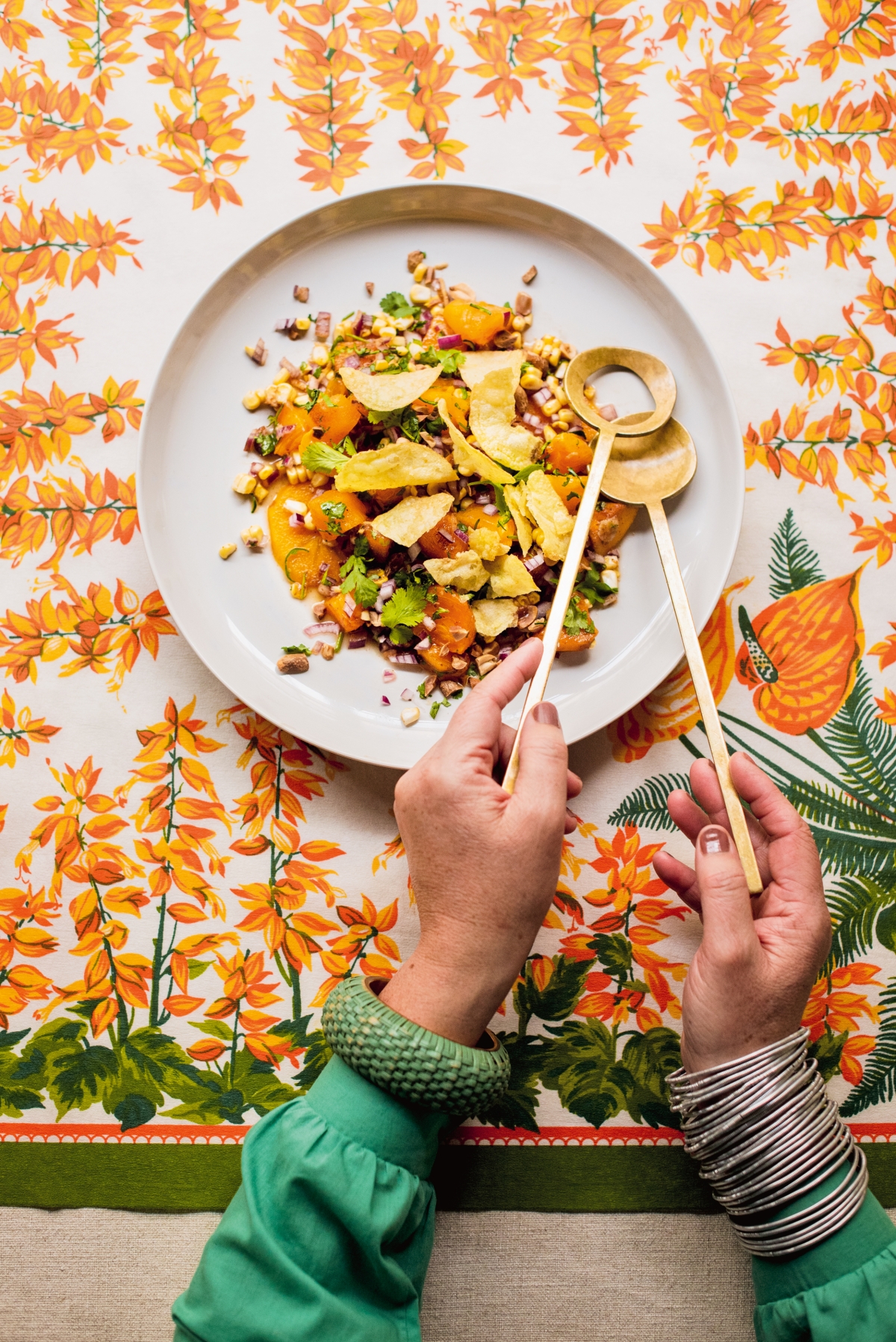 Serves: 4
Serves: 4
3 mealies
2 medium-sized ripe persimmon, cut into 1–2 cm pieces
½ red onion, cut into ½ cm chunks
2 fresh green chillies, thinly sliced
1 clove garlic, very thinly sliced
3 cm piece fresh ginger, peeled and julienned into matchsticks
1/3 cup roughly chopped fresh coriander
½ tsp freshly ground black pepper
2 tsp sugar, divided
2½ tsp chaat masala, divided
¼ cup fresh lime juice, or 2 Tbsp tamarind paste stirred with 2 Tbsp iced water
1/3 cup chopped salted and roasted peanuts
1/3 cup slangetjies (sev), or crushed potato chips
Stand the mealie upright in a medium-sized bowl and slice off the kernels with a sharp knife. Using the back of the knife, scrape along the cob to release the ‘milk’ into the bowl. Add the persimmon (making sure to get all the juices into the bowl too), red onion, chillies, garlic, ginger and coriander, and toss very gently to combine. Sprinkle with black pepper, 1 teaspoon of sugar and 1 teaspoon of chaat masala before tossing again.
Stir in the lime juice and remaining sugar and chaat masala in a small jug until the sugar dissolves. Add the water and stir to combine.
Spoon the salad into individual bowls or into a large salad bowl. Pour the iced lime and chaat water over the salad and top with the peanuts and slangetjies, then serve.
Skirt Steak
with Caper Sultana Relish
“I have always had leanings towards ingredients, cuts and objects that are overlooked, hence my large collection of objects (including, to my family’s distress, sofas and plates) looking for another lease on life. My favourite cut of steak, hardly an old thing, does not get as much attention as its brothers Rump, Sirloin, Rib Eye and Fillet. But flashed over hot coals for mere minutes, you will not find a more satisfying morsel! Its shape and the clarity of its grain might give you an inkling of its tenderness. I rub the skirt steak with salt and white pepper, and it lends itself to a great sear.”
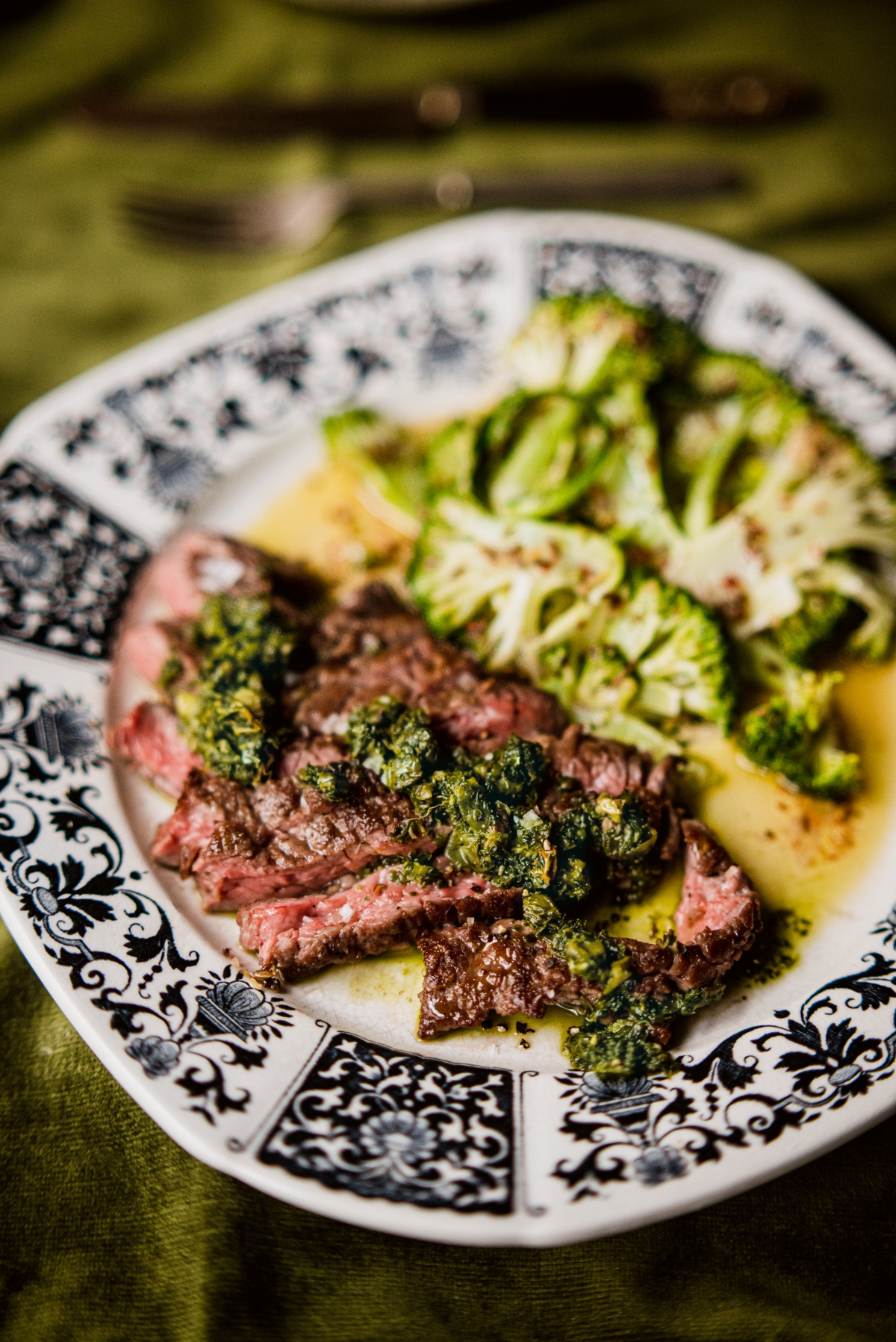 Serves: 4
Serves: 4
450 g skirt steak
Salt and white pepper, to taste
2 Tbsp sunflower oil
¼ cup Caper Sultana Relish (see below)
Extra-virgin olive oil, to drizzle
First, be sure your steak is dry. Use paper towel to pat it dry if it isn’t. This makes for a better sear.
Next, you will need hot coals or a hot cast-iron pan.
If cooking in a pan, rub the steak with salt and white pepper. Then, allow your pan to become very hot. Add the sunflower oil and lower the steak into the pan with tongs. Squash the steak down onto the surface of the pan with a handy spatula or tongs to get a good sear. Open windows and doors – it will get smoky!
If cooking over hot coals, rub the steak with oil, salt and white pepper. Cook the steak for 2–4 minutes on each side – NO LONGER!
Once cooked, place the steak on a board and allow to rest for 5 minutes before slicing. Slice the steak against the grain and spoon over the Caper Sultana Relish, along with a drizzle of olive oil, if you care to.
CAPER SULTANA RELISH
Makes: 1½ cups
½ cup sultanas
2 Tbsp white balsamic vinegar or white wine vinegar
3 cloves garlic, peeled and grated
3 Tbsp capers
6 anchovy fillets
2 Tbsp sunflower oil
1 Tbsp caper brine
40 g Italian (or curly) parsley, very finely chopped
⅓ cup extra-virgin olive oil
Salt and black pepper, to taste
Add the sultanas to a small bowl and pour over the vinegar. Leave them for about 20 minutes to plump up a little.
In a food processor, pulse the garlic, capers, anchovies and sunflower oil to a coarse paste. Add the caper brine, parsley, sultanas with vinegar, and pulse. (You want a coarse relish, so be careful not to overdo it!)
Remove the paste from the food processor, transfer to a bowl and whisk in the olive oil. Season with salt and black pepper.
Satay Roasted Eggplant
“Whenever I make this dish, it is met with rapturous praise. This means that I have made it a number of times, because I am a sucker for applause and affirmation!”
 Serves: 4
Serves: 4
4 large eggplants (± 1.2 kg) (see note below)
± ¾ cup sunflower oil, divided
4 onions, peeled and finely sliced
3 cloves garlic, peeled and minced
1½ fresh long red chillies, very finely chopped
2 stalks lemongrass, top-third discarded and the rest very finely chopped
5 cm piece fresh ginger, peeled and grated
2 Tbsp dark soya sauce
2–3 Tbsp tamarind paste
1 Tbsp soft brown sugar or palm sugar
¾ tsp fine sea salt
250 g crunchy or smooth peanut butter
400 ml water
TO SERVE
Fried onions (shop-bought crispy onions are great here, or you can make your own (see below)
1 Tbsp chopped peanuts
Fresh herbs – a handful each (80 g in total) mint, coriander and dill, all chopped
A NOTE ON THE EGGPLANTS:
I do not salt eggplants. If they are fresh and young, they should be good to go! Generally, I do not peel eggplants either, but if you are worried about a tough roasted skin, do peel the eggplant before slicing it into legs.
Preheat the oven to 200°C and line a baking sheet with baking paper.
Cut each eggplant into an eggplant ‘octopus’: keeping the top of the eggplant intact, slice down lengthways through the middle, then turn it 90 degrees and slice down lengthways again, to create 4 ‘legs’. Slice each leg in half, to create 8 legs.
Working over a large bowl, use a brush or your fingers to coat the whole eggplant thoroughly with oil – all over the 8 legs, all the nooks and crannies, and on the outside. Arrange the eggplants head to foot on the baking sheet and roast in the oven for about 30–40 minutes, or until they are soft and beautifully coloured. Check the eggplants 20 minutes into roasting; you might need to give the legs another brush of oil and turn them around to ensure they roast evenly.
While the eggplants are roasting, make the sauce. Heat a quarter cup of oil in a frying pan over medium-low heat and, once it is hot, add the onions, garlic, chillies, lemongrass and ginger. Fry, stirring regularly, for 15–20 minutes, until soft and translucent. Stir in the soya sauce, tamarind paste, sugar, salt and peanut butter, and cook, stirring, for a couple of minutes. Slowly pour in the water, stirring as you go to create a thick sauce.
This dish makes for great individual plating. Create a generous puddle of sauce on a large soup plate or flat-bottomed salad bowl. Nestle the eggplant octopus in the sauce. Scatter over a handful of fried onions, sprinkle with the peanuts and a generous amount of the fresh herbs. Serve with freshly steamed rice and your favourite pickle.
Fried Onions the Way We Used to Do Them at The Kitchen
Makes: 2½ cups
4 cups sunflower oil
2 cups all-purpose flour
½ cup rice flour
6 onions, finely sliced
Heat the oil in a wok over high heat.
Combine the flours in a medium-sized mixing bowl.
Toss the sliced onions into the flour mixture, one handful at a time, breaking up the rings as you go so that each one is coated in the flour.
Fry the onions 1–2 handfuls at a time. Using a spider or slotted spoon, turn the rings over in the oil after a few minutes so that they become evenly golden.
Remove the onions with your spider spoon to a cooling rack set over a baking tray.
Warm Broccoli Spoon Salad
“This is an arresting salad, bursting with excellent flavours and so very easy to make. It can stand for a while, too, if you wish to prepare it ahead of time. As the name suggests, it should be eaten from a bowl with a spoon – a much kinder utensil.”
 Serves: 3–4
Serves: 3–4
¼ cup sunflower oil
1 tsp minced garlic
1½ tsp garam masala (or curry powder, ras el hanout, or similar)
1 tsp chaat masala
1½ Tbsp honey or jaggery (see note below)
3 Tbsp freshly squeezed lemon juice
2 Tbsp white wine vinegar
¼ cup toasted almonds, chopped
1/3 cup chopped pitted dates
1 large head broccoli, stems peeled and finely sliced or chopped (I steam mine for 2 minutes in the microwave to add colour)
Salt and black pepper, to taste
½ cup chopped fresh Italian parsley, to garnish (optional)
Heat the oil in a small pan over medium heat. Add the garlic, garam masala and chaat masala, and cook for 2 minutes, stirring constantly. Remove from the heat and add the honey (or jaggery), lemon juice, vinegar, almonds and dates. Stir well to combine.
Pour the hot mixture over the raw (or briefly steamed) broccoli and toss to coat.
Season with salt and black pepper, and garnish with a little extra parsley if you have.
Serve immediately.
NOTE
Jaggery is a soft cane and palm sugar that originates on the Indian subcontinent. It has a rich caramel flavour. If you can’t find it in Indian or Cape Malay shops, substitute with coconut sugar.
Melting Caramelised Cabbage
with Ginger-Fennel Smoor
“This is a hug of a dish. Sometimes we need a reassuring dish to let us know that everything is going to be OK – different to what we might have planned – and that there are sunrises and sunsets, sometimes aching hearts and grief but also bowls of melting cabbage for comfort and restoration. This smoor is a great one to have in your arsenal.”
 Serves: 4–6
Serves: 4–6
FOR THE GINGER-FENNEL SMOOR
2 medium onions, chopped
3 cloves garlic, minced
3 cm piece fresh ginger, minced
¼ cup extra-virgin olive oil
1 tsp ground coriander
1 tsp ground cumin
1 tsp fennel seeds
½ tsp dried chilli flakes
¼ cup tomato paste
5 ripe tomatoes (preferably plum), diced, or 1 can diced tomatoes
2 Tbsp soya sauce
1 Tbsp sugar or honey
3 Tbsp ouzo (optional)
½ cup water
1 tsp salt and white pepper, to taste
FOR THE CARAMELISED CABBAGE
3 Tbsp vegetable oil
1 medium cabbage, sliced into 8 wedges with the core intact (it keeps the wedges together)
½ cup water
2 Tbsp extra-virgin olive oil
Salt and black pepper, to taste
TO SERVE
½ cup Greek yoghurt
A few sprigs of fresh dill, picked
Harissa or sriracha sauce (optional), to taste
To make the Ginger-Fennel Smoor, fry the onions, garlic and ginger in the olive oil over medium-high heat for 8–10 minutes, until the onions are translucent. Add the coriander, cumin, fennel seeds and chilli flakes, and fry for another 5 minutes, stirring regularly. Add the tomato paste, tomatoes, soya sauce, sugar, ouzo (if using), salt and white pepper. Let the sauce bubble away for another 15 minutes over low heat until it thickens slightly. Pour the tomato sauce into a baking dish (preferably one with a lid) that you will use for the caramelised cabbage wedges.
Preheat the oven to 180°C.
To make the Caramelised Cabbage, heat the vegetable oil in a large pan and fry the cabbage wedges, cut-side down, over high heat for 3–5 minutes on each side, until they caramelise on the edges. You will need good tongs to turn them. Place the caramelised wedges in the baking dish on top of the tomato sauce. If the wedges have disintegrated slightly while frying, use your tongs to piece them together into your baking dish. When all are done, pour the water around the cabbage wedges and drizzle with the olive oil. Season the cabbage wedges with salt and black pepper.
Put the lid on the dish or cover tightly with foil and bake for 30 minutes. Then, remove the cover and bake uncovered for a further 10–15 minutes. The cabbage will be incredibly soft and yielding. Serve with yoghurt, dill, and harissa or sriracha, if you are so inclined.
Ukrainian Yoghurt Pancakes
or Little Doughnuts
“It is amazing what you conjure up as a regular treat for a household (happily) trapped in their Woodstock home with two hapless dogs. What will they eat? Pancakes! Doughnuts! Often at all times of the day and night. Rules are tossed out of the window. Doughnuts at midnight? Doused in golden syrup? Why not! Pancakes for supper? Hang, let’s do it! The puffy airiness in both offers deep comfort in moments of sadness, longing and confusion.
I gleaned this recipe from Mamushka by Olia Hercules. The Ukrainians understood a lot about austerity, resourcefulness and resilience from their assimilation into the Soviet bloc during Cold-War-era Russia. Turns out this recipe also creates the most heavenly little doughnuts when spooned into a hot wok and deep-fried. It is naughty and unnecessary, but I drop blobs of butter onto the hot pile of doughnuts, drizzle them with moskonfyt or golden syrup, and then dust them with powdered sugar as well. Gosh. Austerity and then excess!”
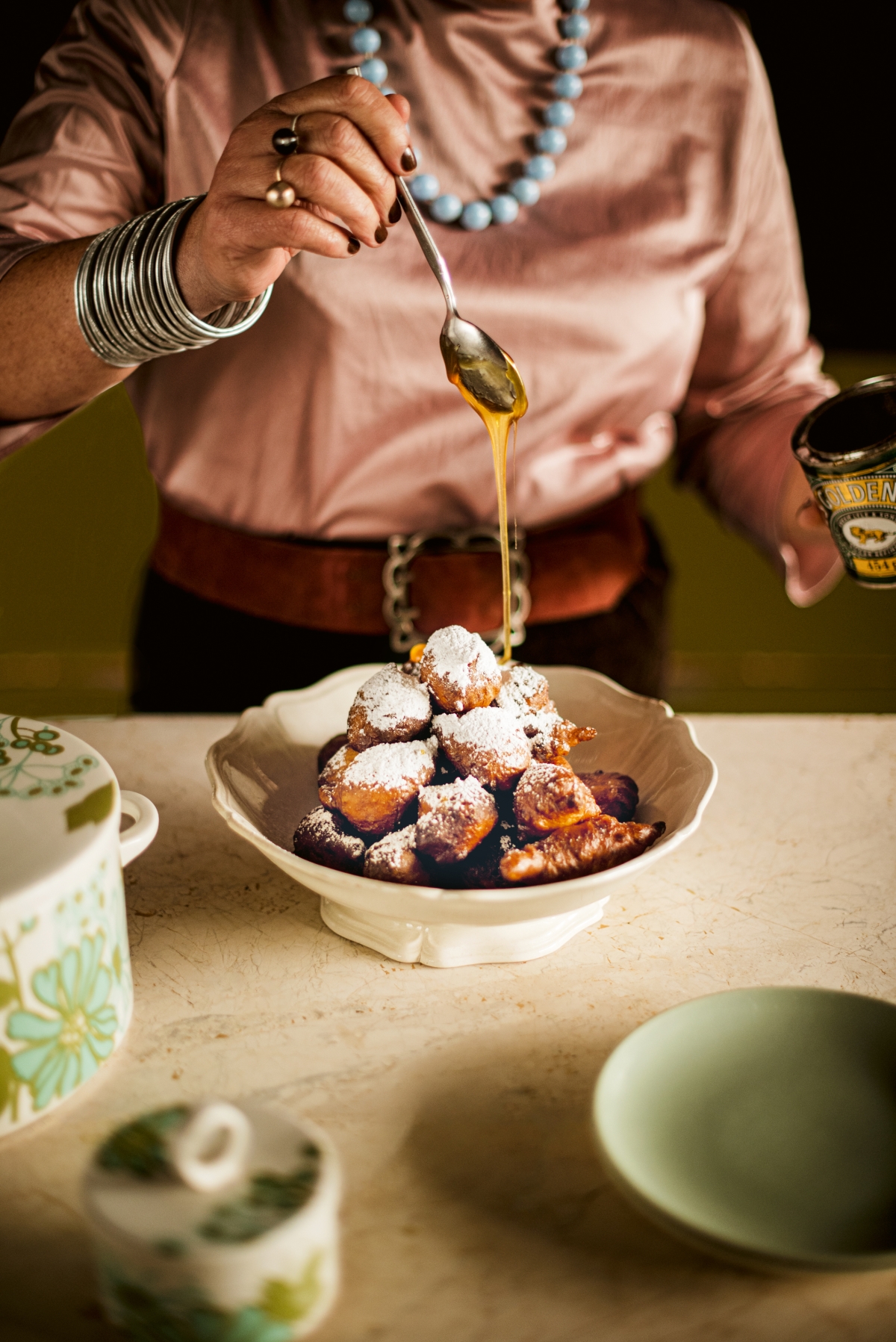 Makes a pile of ± 40 little doughnuts or 24–30 pancakes, depending on their size
Makes a pile of ± 40 little doughnuts or 24–30 pancakes, depending on their size
(serves 4–5 greedy people)
320 ml full-fat yoghurt
2 eggs, beaten
Pinch of fine salt
1½ cups cake wheat flour
1 tsp baking soda
3–4 cups sunflower oil, for deep-frying (doughnuts) OR ¼ cup sunflower oil,
for frying (pancakes)
OPTIONAL TOPPINGS
30 g butter (optional)
Golden syrup, to taste
Powdered sugar, for dusting
Preheat the oven to 150°C. Have a baking sheet ready to pop into the oven to keep the pancakes warm.
Combine all the ingredients (except the oil) and mix until you have a mostly-smooth batter. The batter will be stiffer than you might be accustomed to with flapjacks or American pancakes.
For little doughnuts, heat the oil in a wok over medium-high heat. Drop teaspoonsful of the batter into the hot oil. Turn the doughnuts in the oil so that they fry 1–2 minutes on each side. When cooked and golden-brown, remove and transfer to a tray lined with paper towel. Drop little knobs of butter over the cooked doughnuts, drizzle with golden syrup and dust generously with icing sugar.
For pancakes, heat the oil in a heavy-bottomed pan. Once hot, drop generous dessertspoonsful into the oil, frying gently on both sides until golden and cooked through. These pancakes are exceptionally light and puffy. If you are worried whether they are cooked through, pop them onto a warm baking sheet as they come out of the pan; they will continue to cook gently as you fry all the pancakes.
Serve them hot with all the toppings your family desires.
Recipe extracted from Onwards by Karen Dudley, out now.
YOU MAY ALSO ENJOY
Recipe: Feed my Tribe by Mmule Setati









